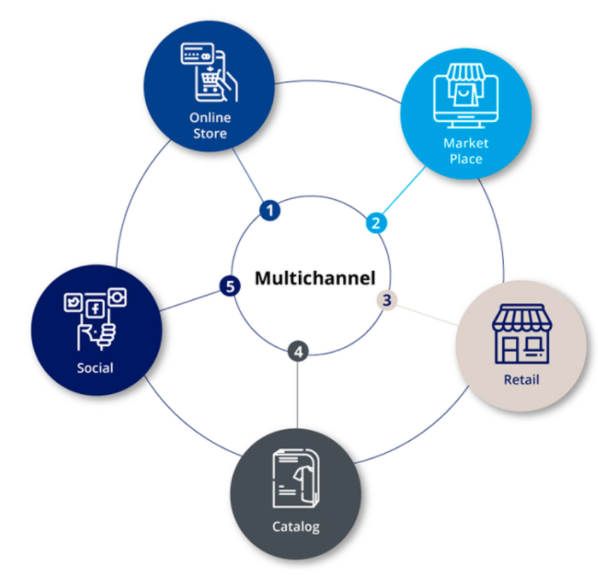Business Enhancer/Multichannel Retailer (1 years course)
Business Enhancer/Multichannel Retailer CLICK HERE
Brief Job Description
Individuals in this position often run high profitability organisations that own their facilities and equipment.
Personal Attributes
The individual needs to be physically fit to be able to fulfil tasks efficiently and be mentally balanced to be
able to motivate self and team to deal with unexpected situations, if any. He/she should also have
business acumen, distributed management skills, people management skills and sales and marketing
skills and customer service skills.
Manage financial operations through robust accounting systems
Description
This unit is about understanding and implementation of financial activities critical to business.

Elements and Performance Criteria
Prepare and manage financial budget
To be competent, the user/individual on the job must be able to:
PC1. describe business policy and procedures in regard to preparation of budget or target figures
PC2. present proposed budgets or targets accurately and concisely to the concerned stakeholders
PC3. negotiate necessary changes to agreed budget allocations if necessary
PC4. monitor income and expenditure and maintain expenditure within budget targets according
to business policy
PC5. take prompt corrective action where significant deviations from budget occur
PC6. enforce budget audit mechanisms and compliance requirements
Maintain Profit and Loss Accounts and business accounting systems
To be competent, the user/individual on the job must be able to:
PC7. ensure team ability to conduct basic accounting tasks, creating and maintaining reports
PC8. build team ability to analyse sources of profits and causes of losses as reflected in the
reports
PC9. ensure implementation of checks to prevent monetary losses due to fraudulent activities
PC10. monitor and maintain business systems for recording sales figures, revenue, personnel and
payroll information, and expenditure
Take measures to control costsNegotiate and generate credit from vendors/suppliers
To be competent, the user/individual on the job must be able to:
PC11. implement cost reduction measures according to business policy and procedures
PC12. encourage team members to actively control costs in their areas of responsibility
PC13. implement recommendations for improving cost reduction or communicate to the team
Negotiate and generate credit from vendors/suppliers
To be competent, the user/individual on the job must be able to:
PC14. describe the business cycle from accounting point of view
PC15. calculate credit amount, credit period, break-even point and payment schedules
PC16. define vendor credit cycle to ensure smooth borrowing process
PC17. negotiate to arrive at the most profitable vendor relationship for the organization and finalize
credit cycle
Raise additional funds for business expansion
To be competent, the user/individual on the job must be able to:
PC18. identify credit sources for business expansion
PC19. describe the terms and conditions of sources offering credit
PC20. identify risks involved in each of sources be considered
PC21. select suitable source of credit
Establish trading terms for the business
To be competent, the user/individual on the job must be able to:
PC22. define processes for approving trading terms
PC23. establish supplier trading terms
PC24. define business customer/direct customer trading terms
PC25. approve trading terms according to business policy and procedures
Knowledge and Understanding (KU)
The individual on the job needs to know and understand:
KU1. organization financial status
KU2. shareholder expectation
KU3. investment mix
KU4. business expansion plans
KU5. reporting forms and formats of the organization
KU6. elements, specific to business, that need to be considered for budgeting and accounting
KU7. risks management while expanding business
KU8. systems that enable timely collection, management and processing of information
Generic Skills (GS)
User/individual on the job needs to know how to:
GS1. complete accounting / financial documentation accurately
GS2. maintain accurate and up to date records of resource allocation and usage according to
company guidelines
GS3. complete records of budget performance and expenditure and report according to company
procedures and guidelines
GS4. read information accurately
GS5. assess and interpret information on costs and resource allocation
GS6. use gestures or simple words to communicate where language barriers exist
GS7. use questioning to minimise misunderstandings
GS8. display courteous and helpful behaviour at all times
GS9. make appropriate decisions regarding the responsibilities of the job role
GS10. plan and organize service feedback files/documents
GS11. schedule daily activities and draw up priorities; allocate start times, estimate completion
times, materials, equipment and assistance required for completion
GS12. build customer relationships and use customer centric approach
GS13. identify problems immediately and take up solutions quickly to resolve delays
GS14. think through the problem, evaluate the possible solution(s) and adopt an optimum /best
possible solution(s)
GS15. interpret and infer financial data
GS16. break down complex problems into single and manageable components within his/her area
of work
GS17. apply, analyze, and evaluate the information gathered from observation, experience,
reasoning, or communication, as a guide to thought and action
Establish legal, statutory and risk management requirements for business
Description
This unit deals in sub tasks that lead to ensuring implementation of statutory compliances, laws, policies
and procedures for managing a business.

Elements and Performance Criteria
Determine legal structure of the business
To be competent, the user/individual on the job must be able to:
PC1. determine legal options for the most suitable type of business structure
PC2. determine legal rights and responsibilities of the business to ensure business is
adequately protected under legal and legislative provisions
PC3. confer with relevant business partners, business principles, franchisors and funders to
inform final decision regarding business structure
PC4. seek legal and accounting expertise as required to inform final decision regarding
business structure
Liaison and interact with local corporations and government bodies for smooth conduct of business Secure
rights to products and services
To be competent, the user/individual on the job must be able to:
PC5. liaison with key officials of local corporations and government bodies that have a
bearing on the particular business
PC6. interact and maintain relationships with the key persons to ensure smooth
functioning of business
Secure rights to products and services
To be competent, the user/individual on the job must be able to:
PC7. secure information on purchase rights to products and services and ensure full
understanding of their implications
PC8. establish cost of procurement rights to products and services, including ongoing
financial planning
PC9. determine brand ownership and protection rights
PC10. secure contractual procurement rights to provide optimal conditions for procurement
of products and services
Ensure statutory compliances, quality norms with respect to manufacturing and selling of products and services
To be competent, the user/individual on the job must be able to:
PC11. ensure that shops and establishments follow policies and procedures that have a
bearing on the business
PC12. ensure recording of errors and exceptions and conduct personal checks on such
records to reduce such instances
PC13. understand the concept of minimizing losses and maximizing gains by ensuring
quality of goods
Ensure compliance of parties undertaking business transactions
To be competent, the user/individual on the job must be able to:
PC14. determine legal rules relating to ownership of assets and intellectual property
PC15. apply legal rules relating to the transfer of risk
PC16. design and issue warranties in compliance with relevant legislation
PC17. ensure insurance for business operations and products complies with relevant
legislation
PC18. determine legal remedies and enforcement options available for the resolution of
disputes
Ensure overall hygiene factors and safety hazards, update self and team on handling of goods,
equipment, hazardous material to improve safety conditions at workplace
To be competent, the user/individual on the job must be able to:
PC19. ensure implementation of processes involved in the business
PC20. ensure checks and balances to prevent hazards and risks involved in the process
PC21. ensure implementation of procedures to handle emergencies and mitigate risks
Ensure implementation of security procedures with respect to monetary transactions
To be competent, the user/individual on the job must be able to:
PC22. describe to the team about possible fraudulent activities
PC23. ensure improvement of processes to minimise losses due to errors and fraudulent
activities
Knowledge and Understanding (KU)
The individual on the job needs to know and understand:
KU1. local corporations/authorities that have a bearing on the particular business process
KU2. policies and procedures that have a bearing on the particular business process
KU3. legal formalities applicable for the particular business
KU4. required team capability to ensure relevant functions
KU5. knowledge of the processes involved in the business
KU6. hazards and risks involved in the business
KU7. quality norms relevant to the business/processes/services
Generic Skills (GS)
User/individual on the job needs to know how to:
GS1. complete legal documentation accurately
GS2. collate legal data when required
GS3. read information accurately
GS4. read and interpret data sheets
GS5. use gestures or simple words to communicate where language barriers exist
GS6. use questioning to minimize misunderstandings
GS7. display courteous and helpful behavior at all times
GS8. make appropriate decisions regarding the responsibilities of the job role
GS9. plan and organize service feedback files/documents

GS10. schedule daily activities and draw up priorities; allocate start times and completion timelines
GS11. build customer relationships and use customer centric approach
GS12. identify problems immediately and take up solutions quickly to resolve delays
GS13. think through the problem, evaluate the possible solution(s) and adopt an optimum /best
possible solution(s)
GS14. interpret and infer data
GS15. break down complex problems into single and manageable components within his/her area
of work
GS16. apply, analyze, and evaluate the information gathered from observation, experience,
reasoning, or communication, as a guide to thought and action
Manage business to achieve operational excellence
Description
This unit is about business management activities.
Elements and Performance Criteria
Drive operational excellence
To be competent, the user/individual on the job must be able to:
PC1. understand similar businesses
PC2. drive the team to collect and compile relevant market data needed to plan business offerings
PC3. analyse compiled market data to identify need and plan assortment accordingly
PC4. ensure effective inventory management with implementation of re-order mechanism
quantity and lead time as defined in store/organization processes
PC5. minimize losses from ageing/damaged/expired stock
PC6. determine operational costs and set targets and sales figures to maximize profits
PC7. negotiate and generate credit from vendors/suppliers
PC8. plan for contingencies in case of deviations
PC9. ensure optimum utilization of resources in daily operations
PC10. ensure the required precautions are taken and timely maintenance of equipment
PC11. ensure team updating on new technology that can improve efficiencies and reduce risks
PC12. ensure team competence on using of equipment relevant to business
PC13. ensure insurance and safekeeping of all goods and properties involved in the business
Manage e commerce solutions
To be competent, the user/individual on the job must be able to:
PC14. identify technologies relevant to e-commerce solutions
PC15. determine capabilities and limitations of the internet
PC16. determine impact and use of websites
PC17. determine e commerce solutions for compliance to business outcomes and customer
requirements
PC18. monitor e commerce system for ability to meet peak demands
PC19. collect and review strategic data on ongoing effectiveness of e commerce solutions
PC20. ensure modifications or customization of e commerce systems to meet changing internal or
external customer demands
Knowledge and Understanding (KU)
The individual on the job needs to know and understand:
KU1. similar businesses and their highs and lows
KU2. possible business risks
KU3. market study
KU4. inventory management
KU5. integration of technology to retail processes
KU6. proposal evaluation
KU7. project planning
KU8. contingency management
Generic Skills (GS)
User/individual on the job needs to know how to:
GS1. write intelligibly
GS2. maintain accurate and up-to-date records of resource allocation and usage according to
company guidelines
GS3. complete records of budget performance and expenditure and report according to company
procedures and guidelines
GS4. read and understand business planning documents
GS5. read and understand risk-assessment documents
GS6. explain documents related to own business
GS7. make appropriate decisions regarding the responsibilities of the job role
GS8. plan and organize service feedback files/documents
GS9. build customer relationships and use customer centric approach
GS10. identify problems immediately and take up solutions quickly to resolve delays
GS11. think through the problem, evaluate the possible solution(s) and adopt an optimum /best
possible solution(s)
GS12. interpret data and take a call on future operations
GS13. apply, analyze, and evaluate the information gathered from observation, experience,
reasoning, or communication, as a guide to thought and action
Ensure product, pricing and promotions are in harmony to
augment sales and profitability
Description
This unit deals in activities that help in augmenting sales and profitability with the help of appropriate
products, prices and promotions.
Elements and Performance Criteria
Conduct market analysis to identify need and plan assortment/stocks accordingly
To be competent, the user/individual on the job must be able to:
PC1. identify target audience/ consumer profile
PC2. identify buying patterns and analyse sales data to define assortments and modify them as
per trends observed
PC3. understand competitors/other players/ substitute products
PC4. determine means to forecast demands on inventory
PC5. describe the importance for monitoring market trends and technology changes as part of
managing inventory demands
Effective inventory and sales management
To be competent, the user/individual on the job must be able to:
PC6. determine inventory/procuring capacity and ensure required inventory is on hand as per
demand
PC7. monitor stock levels and maintain at required levels
PC8. calculate and assess operational costs, profits and margins
PC9. define targets for self and team to achieve business gains
PC10. match logistics of delivery to inventory supply requirements
PC11. take steps to prevent inventory losses and plan for contingencies in case of stock out
Knowledge of Product /services and promotions
To be competent, the user/individual on the job must be able to:
PC12. understand product/s involved in the business
PC13. describe market trend with respect to sales patterns of related products
PC14. describe related products and possible opportunities with respect to up- selling, cross selling,
expansion of business etc.
PC15. ensure quality check of products/services to maintain quality and conform to statutory
quality requirements
PC16. analyze addition/deletion of product lines to maximize profits and minimize losses
PC17. identify the most effective channels of promotions for the target group and achieve
maximum success by getting relevant promotional events executed
PC18. optimize the use of social media to achieve maximum reach and penetration
Manage retail brands online
To be competent, the user/individual on the job must be able to:
PC19. establish strategic fit of brand online features with business purpose
PC20. integrate online and other brand management strategies
PC21. determine online consumer attitudes to brand
PC22. determine comparative advantage of brand over competitors in an online environment
PC23. determine methods to communicate the brand in an online form
PC24. set indicators for measuring ongoing brand value and success
Pricing policy
To be competent, the user/individual on the job must be able to:
PC25. ensure team competence in selling/servicing of products/services being sold at optimum
costs and with minimum wastages/losses
PC26. price products to achieve organisation goals and enhance profitability
Knowledge and Understanding (KU)
The individual on the job needs to know and understand:
KU1. company and competition
KU2. pricing policy and the working for the same
KU3. promotional history of the organization
KU4. management of inventory and sales
KU5. pricing and promotions across the industry
KU6. current market conditions
Generic Skills (GS)
User/individual on the job needs to know how to:
GS1. create and document pricing policies
GS2. ideate promotional themes and events
GS3. read and understand relevant schemes and policies
GS4. explain relevant schemes and policies to teams and partners
GS5. make appropriate decisions regarding the responsibilities of the job role
GS6. plan and organize service feedback files/documents
GS7. build customer relationships and use customer centric approach
GS8. identify problems immediately and take up solutions quickly to resolve delays
GS9. think through the problem, evaluate the possible solution(s) and adopt an optimum /best
possible solution(s)

GS10. interpret and infer market data
GS11. break down complex problems into single and manageable components within his/her area
of work
GS12. apply, analyze, and evaluate the information gathered from observation, experience,
reasoning, or communication, as a guide to thought and action
Effectively manage customer experience
Description
This unit deals in sub tasks that ensure enhancing customer satisfaction by identifying needs and building
relationships with customers such that customers are not lost.
Elements and Performance Criteria
Enhancing customer satisfaction by identifying need and desire
To be competent, the user/individual on the job must be able to:
PC1. identify target customers and understand their need and desire
PC2. identify possible options to satisfy customer needs
PC3. present options in an attractive manner that are mutually beneficial in nature
Build strong relationships and network
To be competent, the user/individual on the job must be able to:
PC4. describe the concept of building relationships with customers to generate referrals
PC5. collect feedback to improvise to increase business returns and reach
PC6. ensure on-time delivery service fulfilment
PC7. ensure implementation of customer loyalty programs like vouchers, promotions
Communicate with customers using technologies
To be competent, the user/individual on the job must be able to:
PC8. identify procedures and test operation of technologies and associated applications in line
with nature of customer contact
PC9. gather and apply feedback from relevant staff on operation of technologies
PC10. explain the benefits of communication using technologies relevant to customers
PC11. collect required customer data for communication using technologies
PC12. process customer data according to workplace procedures
PC13. apply suggested improvements to improve customer communications
Knowledge and Understanding (KU)
The individual on the job needs to know and understand:
KU1. target customer
KU2. customers expectation of products and service levels
KU3. service fulfillment commitments and standards
KU4. customer loyalty programs like vouchers, promotions
KU5. how to build customer referrals
KU6. technology platform for customer customer communication
KU7. how to build schemes for existing customers and attract new customers
KU8. current schemes run by similar organizations
Generic Skills (GS)
User/individual on the job needs to know how to:
GS1. record data relevant to customer service
GS2. complete statutory documents relevant to service levels
GS3. read and understand data relevant to customer service
GS4. read and understand statutory documents relevant to service levels
GS5. explain service details if and when required
GS6. make appropriate decisions regarding the responsibilities of the job role
GS7. plan and organize service feedback files/documents
GS8. build customer relationships and use customer centric approach
GS9. identify problems immediately and take up solutions quickly to resolve delays
GS10. think through the problem, evaluate the possible solution(s) and adopt an optimum /best
possible solution(s)
GS11. interpret and infer data
GS12. break down complex problems into single and manageable components within his/her area
of work
GS13. apply, analyze, and evaluate the information gathered from observation, experience,
reasoning, or communication, as a guide to thought and action
Manage human resources
Description
This unit deals in sub tasks that are about assessing, recruiting, training and retaining adequate and
appropriate manpower.
Elements and Performance Criteria
Effective management of the human resources
To be competent, the user/individual on the job must be able to:
PC1. ensure conformance to procedures for interviewing, hiring, evaluating and preparing job
description for new employees
PC2. ensure employee connect, offer career prospects, communicate organizational goals and
objectives and congratulate on success
PC3. ensure training and development of team in a manner that benefits organization and also
fulfils personal objectives
Knowledge and Understanding (KU)
The individual on the job needs to know and understand:
KU1. manpower requirement
KU2. training needs
KU3. employee engagement needs
KU4. HR policies
KU5. industry norms for manpower engagement
KU6. essential statutory compliances
Generic Skills (GS)
User/individual on the job needs to know how to:
GS1. document manpower-related requirements and create/change/amend policies
GS2. read and understand manpower-related requirements and created/changed/amended
policies
GS3. explain manpower-related requirements and created/changed/amended policies
GS4. conduct training and other such interventions for team
GS5. make appropriate decisions regarding the responsibilities of the job role
GS6. plan and organize service feedback files/documents
GS7. build customer relationships and use customer centric approach
GS8. identify problems immediately and take up solutions quickly to resolve delays
GS9. think through the problem, evaluate the possible solution(s) and adopt an optimum /best
possible solution(s)
GS10. interpret and infer data
GS11. break down complex problems into single and manageable components within his/her area
of work
GS12. apply, analyze, and evaluate the information gathered from observation, experience,
reasoning, or communication, as a guide to thought and action
Demonstrate leadership behavior to achieve organizational objectives
Description
This unit deals in sub tasks that are about leadership skills to ensure effective team management.

Elements and Performance Criteria
Motivate self to enhance and grow his/her business
To be competent, the user/individual on the job must be able to:
PC1. understand entrepreneurial thinking and perspective
PC2. participate in workshops, seminars and engage with other successful business owners
PC3. drive self-development through available mediums
PC4. identify and get certifications in related line of business
Display creativity and innovation for sustenance and business growth
To be competent, the user/individual on the job must be able to:
PC5. identify opportunities and create solutions to face uncertainties
PC6. keep self-updated to be able to expand business in other fields/line of business as desired
PC7. improvise methods so as to improve efficiencies
Lead team
To be competent, the user/individual on the job must be able to:
PC8. lead team by communicating team objectives
PC9. direct the organization and motivate team to seek defined objective enthusiastically
Knowledge and Understanding (KU)
The individual on the job needs to know and understand:
KU1. success stories in the related field
KU2. innovations in the relevant product/service
KU3. team motivators
KU4. strengths, weakness, opportunity of and threat to self and own organization
Generic Skills (GS)
User/individual on the job needs to know how to:
GS1. record innovation made
GS2. chronicle success stories
GS3. make a milestone-based growth chart
GS4. read and understand chronicles and success stories
GS5. read and understand self/other growth chart
GS6. explain plans and programs to prospective investors/partners
GS7. make appropriate decisions regarding the responsibilities of the job role
GS8. plan and organize service feedback files/documents
GS9. build customer relationships and use customer centric approach
GS10. identify problems immediately and take up solutions quickly to resolve delays
GS11. think through the problem, evaluate the possible solution(s) and adopt an optimum /best
possible solution(s)
GS12. interpret and infer data
GS13. break down complex problems into single and manageable components within his/her area
of work
GS14. apply, analyze, and evaluate the information gathered from observation, experience,
reasoning, or communication, as a guide to thought and action








